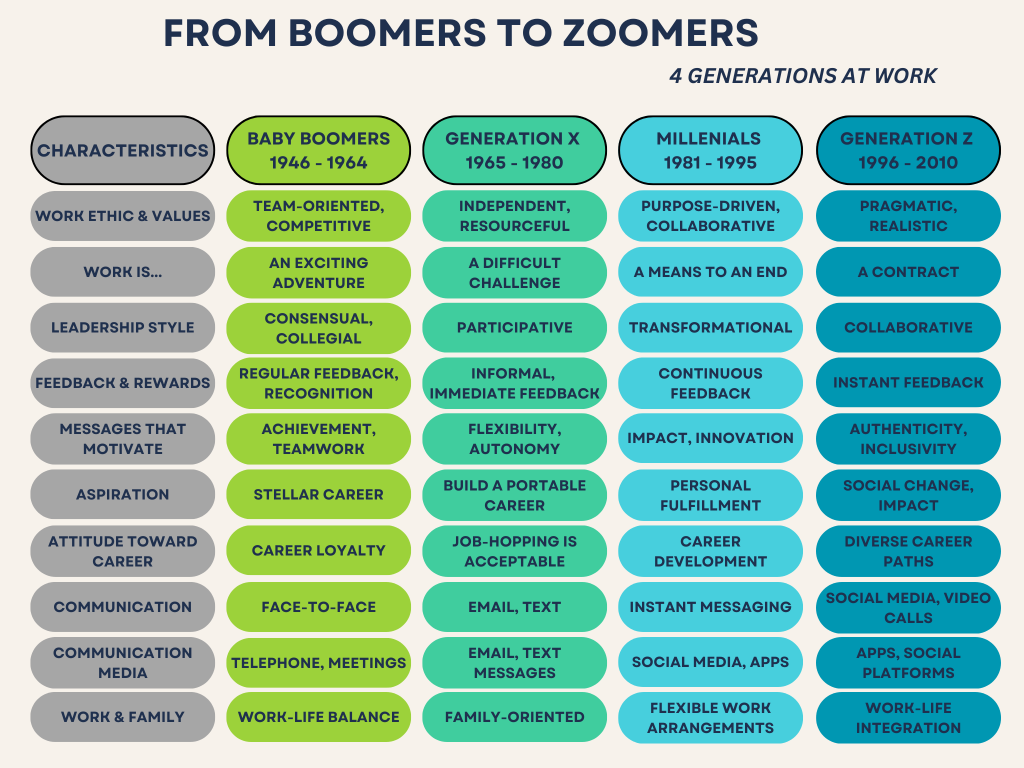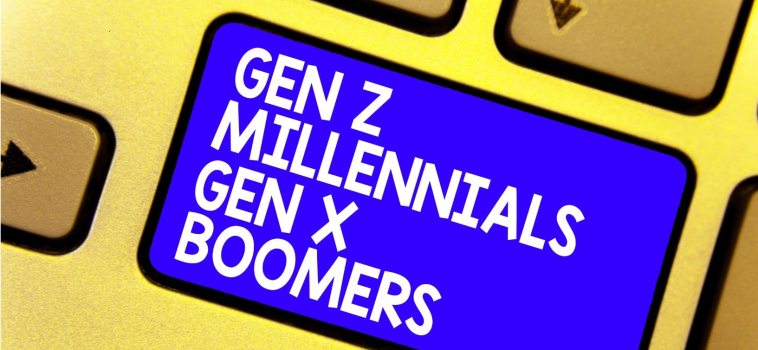From Boomers to Zoomers: Navigating the Multi-Generational Workplace
GEN Z at work
In today’s diverse workplace, understanding generational differences is crucial for fostering collaboration and enhancing productivity. As we look at the various generations—Baby Boomers, Generation X, Millennials (Generation Y), and Generation Z—it becomes clear that their values, motivations, and approaches to work differ significantly. This article explores these differences and how they manifest in the FLIGBY simulation, a tool that helps individuals develop leadership skills in a fun and engaging way.
Generational Characteristics
Baby Boomers, born between 1946 and 1964, are often described as loyal, team-oriented, and competitive. They view work as an exciting adventure and are motivated by achievement and recognition. In contrast, Generation X (1965-1980) is more independent, resourceful, and seeks flexibility and autonomy in their roles. Millennials (1981-1995) are purpose-driven, collaborative, and tend to see work as a means to an end. They value continuous feedback and opportunities for personal fulfillment. Lastly, Generation Z (1996-2010) is pragmatic, realistic, and seeks authenticity and inclusivity. They are motivated by opportunities for growth, social impact, and work-life integration.
Each generation has been shaped by different historical events, technological advancements, and societal norms, resulting in varied approaches to work and communication.

Generational Dynamics in Action
These generational differences play out in various aspects of work life:
- Communication Styles: While Baby Boomers often prefer face-to-face interactions or phone calls, younger generations lean towards digital communication methods like instant messaging and video calls.
- Work-Life Balance: There’s a clear progression from the work-centric mindset of Baby Boomers to the work-life integration sought by Gen Z, with each generation placing increasing importance on flexibility and personal time.
- Career Attitudes: Loyalty to a single company has given way to a more fluid approach to career development, with younger generations more likely to change jobs in pursuit of growth opportunities.
- Leadership Preferences: The command-and-control style favored by older generations has evolved into more collaborative and inclusive approaches preferred by Millennials and Gen Z.
- Feedback and Recognition: The annual review cycle has been replaced by a desire for constant feedback and recognition, particularly among younger workers.
The Value of Generational Diversity
Generational diversity offers numerous benefits to organizations, enhancing creativity, innovation, and overall performance. One of the primary advantages is the increased pool of ideas and perspectives that comes from having team members of varying ages. For instance, younger employees may bring fresh, tech-savvy approaches to problem-solving, while older employees contribute valuable experience and historical context. This blend of perspectives can lead to more innovative solutions and creative strategies that might not emerge in a homogenous group.
Moreover, organizations with a diverse age range often experience improved employee engagement and satisfaction. According to Deloitte’s 2018 Global Human Capital Trends survey, which gathered insights from more than 11,000 business and HR leaders, 74% of organizations believe a multi-generational workforce makes their organization more successful. The study highlighted how these environments foster learning and mentorship opportunities, helping employees gain new skills while enhancing their ability to work together and creating a more cohesive workplace culture.
Additionally, generational diversity can improve organizational resilience. By leveraging the strengths of each generation, organizations can better adapt to changes in the market and workforce dynamics. For example, older employees may have established networks and relationships that can be invaluable during transitions, while younger employees are often more adaptable to new technologies and trends.
Finally, embracing generational diversity can improve customer relations. A workforce that reflects a range of ages can better understand and cater to a diverse customer base, improving service and satisfaction. This alignment with customer demographics can ultimately drive business success and foster loyalty.
Bridging Generational Gaps Through FLIGBY
FLIGBY is a simulation that effectively provides insights into managing generational diversity. It presents players with scenarios that reflect the challenges and dynamics of working with individuals from different age groups. By engaging with characters representing various generations, participants learn to recognize and appreciate diverse perspectives, enhancing their ability to lead inclusive teams. The simulation emphasizes the importance of communication, collaboration, and adaptability, equipping leaders with the skills necessary to bridge generational gaps. Ultimately, FLIGBY is a valuable tool for organizations striving to leverage the strengths of a multi-generational workforce, fostering an environment where all employees can thrive.
The FLIGBY simulation addresses these generational dynamics through carefully crafted scenarios that reflect real-world challenges. Players encounter situations where they must:
- Navigate Communication Styles – Adapt communication approaches for different generations; Bridge understanding between traditional and digital-native team members; Foster open dialogue across generational lines
- Manage Work Preferences—Balance different approaches to work-life integration; address varying expectations about workplace flexibility; accommodate different learning and development styles.
- Handle Conflict Resolution: Mediate between different generational perspectives; address misunderstandings arising from generational differences; find common ground among diverse team members.
- Promote Knowledge Transfer – Facilitate mentoring relationships across generations; encourage skill-sharing between experienced and newer employees; create opportunities for reverse mentoring.
Through these interactive experiences, FLIGBY helps leaders develop practical skills for managing multi-generational teams while leveraging each generation’s unique strengths.
FLIGBY’s Approach to Generational Gaps
FLIGBY offers several strategies for integrating generational differences in the workplace, focusing on developing leadership competencies and fostering a collaborative environment. Here are some critical strategies highlighted in the simulation:
1. Understanding Character Dynamics
FLIGBY immerses players in scenarios where they interact with characters representing different generations. This exposure helps players recognize and appreciate each generation’s distinct values and communication styles. By navigating these dynamics, players learn to adapt their leadership approaches to suit the needs of diverse team members.
2. Promoting Inclusive Leadership
The simulation emphasizes the importance of inclusive leadership styles that resonate with younger generations, such as Millennials and Generation Z. Players are encouraged to adopt participative approaches, fostering collaboration and open communication. This helps bridge the gap between older generations’ more directive styles and younger workers’ collaborative preferences.
3. Tailoring Feedback Mechanisms
FLIGBY highlights the varying expectations around feedback across generations. Players learn to provide immediate, constructive feedback that younger generations value while incorporating the formal review processes that older generations may prefer. This adaptability in feedback methods promotes a more cohesive team environment.
4. Balancing Work Ethics and Values
The simulation challenges players to balance the long-term commitment and stability valued by Baby Boomers with the desire for meaningful work expressed by Millennials and Generation Z. By presenting scenarios that require this balance, FLIGBY helps players develop strategies for aligning team goals with individual motivations.
5. Encouraging Cross-Generational Collaboration
FLIGBY facilitates experiences that promote cross-generational teamwork. Players can engage in mentoring opportunities, where older employees guide younger ones or vice versa. This fosters mutual respect and enhances knowledge sharing and skill development across generations.
6. Conflict Resolution Skills
The simulation presents conflicts that may arise from generational misunderstandings or differing work styles. Players learn to mediate these conflicts by recognizing and valuing each generation’s perspective, equipping them with the skills necessary to resolve disputes effectively and maintain team harmony.
Through these strategies, FLIGBY serves as a practical tool for understanding and addressing generational differences in the workplace. Players can develop their communication, leadership, and teamwork skills by engaging with characters of various age groups. This experiential learning environment encourages future leaders to embrace diversity and create inclusive work cultures that harness the strengths of all generations.
The multi-generational workplace presents both challenges and opportunities. Organizations can create a more inclusive, innovative, and effective work environment by understanding and appreciating each generation’s unique strengths and perspectives. Tools like the FLIGBY simulation can provide valuable insights and practice in navigating these generational dynamics, preparing leaders to thrive in today’s diverse workforce. As we progress, we must remember that while generational trends can provide valuable insights, individual differences always exist. The key to success lies in fostering an environment of mutual respect, open communication, and continuous learning across all generations.





